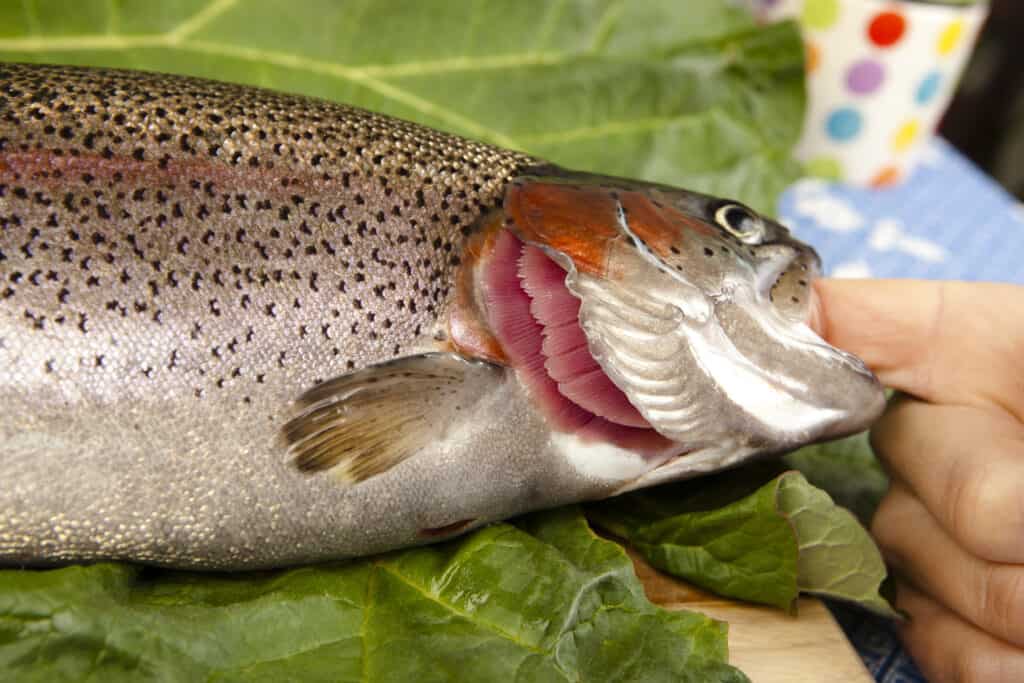A gill is a respiratory organ present in many types of aquatic and semi-aquatic animals.
Summary

This rainbow trout’s gills consist of many thin, parallel filaments, or thread-like structures.
©pfluegler-photo/Shutterstock.com
Gills allow aquatic and semi-aquatic animals to breathe by absorbing tiny particles of dissolved oxygen from water and excreting carbon dioxide as a byproduct of respiration. In most species, they are composed of numerous tiny, thin tissues or folded, branch-like structures. Their folded design helps increase their surface area and respire more efficiently.
Gills are most common and best understood in fish. However, they are also present in many amphibians, as well as invertebrates like insects, crustaceans, and mollusks. Most animals’ gills only function when submerged in water. However, certain partially-aquatic species like hermit crabs have also evolved to be able to use them to respire while on land as long as they stay moist.
Structure
Gill structure can vary from species to species. However, in general, they are very thin, delicate, and compact yet dense. They are sometimes highly folded to maximize their surface area while taking up as little space on the animal’s body as possible. In fish, they consist of many thin filaments, or lamellae. This is because there is very little dissolved oxygen in water, so most species’ gills have to function as efficiently as possible to increase their oxygen absorption.
In many aquatic vertebrates like fish, five to eight pairs of gills are typically present along the walls of the pharynx. The pharynx is a space within an animal’s throat just behind the mouth and nasal cavity and just above the esophagus and trachea. The gills sit within gill slits, or openings that only partially expose them to the surrounding water.
In bony fishes, the gills are also covered by the operculum, a series of connected facial bones. Cartilaginous species like sharks and rays have a similar cartilaginous structure known as a gill arch.
In amphibians, the gills are fully external and exposed to the water with no covering present. They usually disappear as the animal metamorphoses and develops lungs. However, a few species like axolotls and olms retain them as adults.
In certain aquatic invertebrate crustacean and mollusk species, the gills are usually also present directly on the surface of the body. Alternatively, some species’ gills are located along a modified appendage and are covered by a protective chamber. In aquatic insects, the gills are located within the trachea. They are fully protected within the trachea and connect to external tissues, plates, or tuft-like structures to allow water to flow over them.
How Gills Function
Gills function by absorbing dissolved oxygen from water. Next, the gills’ many capillaries, or tiny blood vessels, pick up these particles of oxygen and transport them to the rest of the animal’s body via the blood. Meanwhile, they also excrete carbon dioxide, a byproduct of the respiratory process.
Generally, water simply moves in one direction along an animal’s gills as it swims. Some animals may also utilize specialized appendages, tiny cilia, or pump structures to move the water along their gills. This method is most common in immobile species like certain types of mollusks.
Animals with Gills
As vital organs necessary for breathing, gills are present in most aquatic as well as some semi-aquatic animals. This includes species like both bony and cartilaginous fishes, amphibians, and even aquatic invertebrates like mollusks, crustaceans, and insects.
Pronunciation
Gill is pronounced /ɡɪl/ (International Phonetic Alphabet).



